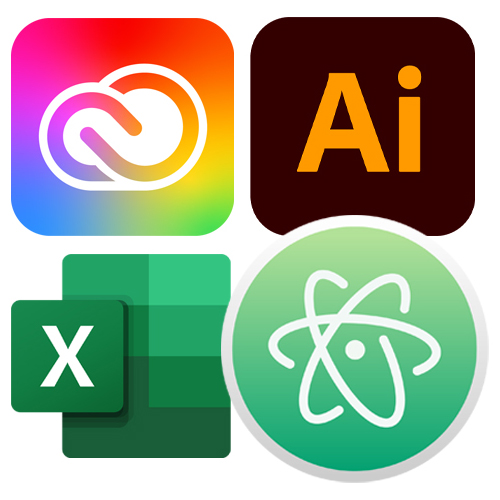Please scroll down
Information Graphics
5 sections comprise J464, beginning with an introductory unit on graphic foundations, proceeding with each of the three major “food groups” of information graphics — charts, maps and diagrams. We will lay the foundations for your J464 Portfolio website early in the semester, then add progressively to it, culminating in a “final project’ deadline for the Monday of Finals week, at which tinme your published site must fully updated.
As we study each unit, we will learn new skills and incorporate them into three major graphics projects: a chart-based infographic, an information graphic that includes a significant geographic component, and an explanatory diagram. Each will be uniquely researched and produced and submitted as static, “print” versions, though you will be publishing them on your J464 class website throughout the semester (the final version of this site will be your final project). For grading purposes, the projects make up three-fifths of your final grade; the rest will be based on quizzes, deadline assignments and your participation in class, as measured by your compiling a collection of your in-class exercises.
Projects: You will have the opportunity to create your three major project graphics, in each of the three major units, based on subject matter that is of particular interest to you. I will be available to help guide your choices, help you identify viable sources and provide feedback and suggestions as your work progresses. You alone will research, write and render all the content for these projects. This is the biggest part of your grade: each project is worth 15 percent of your final score.
Participation: We have 29 scheduled class sessions, every Monday and Wednesday beginning at 1:15 in Franklin Hall, room 003, over the next 15 weeks (excepting MLK Day and Spring Break). Most sessions will include a short lecture, some instruction in how to use the programs (primarily Excel and Illustrator, but later incorporating some online resources), and prompts for exercises in creating a variety of information graphics.
Class sessions will regularly feature how-to tutorials (as PDF handouts and sometimes with pre-recorded videos) as well as skills-building creative exercises, where you must produce a graphic based on information you will either be given or that you will have to go and find. (These exercises will not be graded, but their completion determines your “participation” score, which is another 15 percent of your grade).
Quizzes: We will have four short quizzes, at the end of each of the four units. Quizzes are intended to reinforce points from lectures and computer skills. They will be short and a relatively small part of your grade — just 10 percent — but they do count. We will take quizzes together in class and review answers in the following session.
Deadliners: During three of our class sessions, we will have graded “deadline” assignments, in which you will produce a finished graphic within the two-hour class period. “Deadliners” are designed to allow you to practice your skills in graphic journalism and to replicate real-world/breaking news situations. I will provide you with the data and certain parameters for these assignments, and you will create the finished graphic within a tight two-hour deadline. each is worth 5 percent of your final grade, so 15 percent collectively.
You can see the dates for our lectures in the calendar page of this syllabus, and the dates for your projects, quizzes and Deadliners on Canvas. Do bear in mind that these dates are subject to change depending on our progress. (They will only ever change to a later date, never an earlier one, and I will give you advance warning if and when this occurs.)
Feedback and critiques
To be successful in any medium, especially a visual one, you must be able to separate yourself from your work, consider it objectively, determine ways in which it is “not working” and ways in which you can improve it. In this class, understanding the process a graphic goes through is as important as your finished piece. And in my experience, it is rare that a graphic is successful without the benefit of the input from others.
My goal here is to create an environment where you feel comfortable giving and receiving feedback during the creative process and immediately after handing in an assignment. We'll look more closely at developing techniques for giving and receiving criticism later in the semester, but for now, I want to stress the importance of your remaining forever open to ways you can improve your work.
Your grade on each assignment will be a numerical score based on your ability to identify critical and interesting information, your visual creativity, the technical execution and effectiveness of your design and the overall aesthetic quality of your finished work. Writing is as important in graphics as illustration, and writing for graphics is a unique skill. Your grade will also reflect your ability to write clearly and concisely for each of your graphics, and to emphasize the key points. All your projects require your research into your chosen topic; you must, for each one, submit your source material so I can check the veracity of your work.
Procedures and materials
We will make heavy use of the computers in our classroom, but you may use your own computer if your prefer. There will not be great deal of things to buy — no textbooks or required materials — but you will likely do a good deal of work outside of our building. For this, you will need to make sure your machine includes the following:
 Software: You will need Adobe Creative Cloud, especially Illustrator, and Microsoft Excel, plus a text-editing program (like Sublime).
Software: You will need Adobe Creative Cloud, especially Illustrator, and Microsoft Excel, plus a text-editing program (like Sublime).
 Canvas: I will use Canvas to provide you with any and all materials for exercises, tutorials and projects, and will post handouts and lecture PDFs there, too. You will also submit all your assignments — projects, exercises and Deadliners — to Canvas, as well as take your quizzes there (during class). The class will be divided into modules, so you will be able to see assignments and handouts, for example, on a week-by-week basis.
Canvas: I will use Canvas to provide you with any and all materials for exercises, tutorials and projects, and will post handouts and lecture PDFs there, too. You will also submit all your assignments — projects, exercises and Deadliners — to Canvas, as well as take your quizzes there (during class). The class will be divided into modules, so you will be able to see assignments and handouts, for example, on a week-by-week basis.
As you are no doubt aware, Two-Step Login (Duo) is required for all students to access IU systems (including Canvas).
If you still need to set up Duo, get started at: twostep.iu.edu.
Learn more about recommended devices at: https://kb.iu.edu/d/anfl.
For help resources, see: https://kb.iu.edu/d/aluu.
 Pages: Starting fairly early in the semester, you will be publishing your work on your own class site, via IU’s Pages server. If you have used this before, be aware that you may need to re-agree to the terms of service for Pages. The server is ssh-pages.iu.edu, and your URL will based on your IU username (dot-pages-dot-iu-dot-edu-slash whatever subdirectory you make). You can find out more about Pages at https://kb.iu.edu/d/bggi.
Pages: Starting fairly early in the semester, you will be publishing your work on your own class site, via IU’s Pages server. If you have used this before, be aware that you may need to re-agree to the terms of service for Pages. The server is ssh-pages.iu.edu, and your URL will based on your IU username (dot-pages-dot-iu-dot-edu-slash whatever subdirectory you make). You can find out more about Pages at https://kb.iu.edu/d/bggi.
You will need to use a VPN to access the server if you are off campus. For this, you would need to download and install the Avanti Secure VPN client. It’s free from UITS.
More on the VPN can be found here: https://kb.iu.edu/d/ajrq.
For details on installing and configuring Avanti Secure: https://kb.iu.edu/d/aygt. (Avanti is simply a re-branding of Pulse Secure, and you can continue to use that software if you already had installed and configured it.)
I recommend that you maintain a folder dedicated to J464 this semester, not only on your own hard drive, but also on a Google@IU drive, or using Microsoft OneDrive. Much of our in-class work will stretch across two or more class sessions, and you will need to make sure you do not have trouble accessing your files — much of our work will involve more than a single file, so take care not to misplace source material or break links. Start the semester with good organizational habits and maintain them throughout.

There are no required materials In J464, but you will want materials handy to sketch ideas while you conceiving your graphics. A sketchbook you like and a few drawing pencils, therefore, are strongly recommended.

In Franklin Hall, we will draw in Illustrator using the mouse, as mice are attached to all the Macs in Franklin. Learning to draw in Illustrator is a key component of our class, but you don't necessarily need a mouse to do so — you are free to use a trackpad or a tablet if you prefer. If you’d like to buy a mouse for this class, a Magic Mouse (for Mac) is $69 from Amazon — this is the model I would recommend — though you can use practically any mouse you like, and they can be had for much less.
Rules etc.
Attendance: We will produce something of value in every session, and I believe that every class is important to your learning. Attendance is therefore required. If you do miss a session, please review the posted lecture PDF (on Canvas) and make sure you stay up to date with any assignments.
Make-ups: You can make up a missed Deadliner or quiz with an excused absence — alternate assignments will be made available in such cases. Excused absences are religious holidays (you must fill out a form for this), illness, participation in an IU-sanctioned event (like a class trip or if you're a student athlete) or a death in the family.
Deadlines: Deadlines are the lifeblood of journalism, and blowing deadlines in this business is simply not tolerated. I am, however, aware that university life sometimes places additional pressures on students and that it is not inconceivable that some assignments, once in a great while, may have to be handed in late. If this should happen to you, I will accept late projects for the first five calendar days after deadline. I will take off 10 percent per calendar day, though, so it's in your interest to be on time. If you are having problems meeting a deadline, please let me know ahead of time. Note that Deadliners, which must be submitted at the end of their class sessions, cannot be submitted late. Any Participation exercises, on the other hand, can be submitted late without penalty all the way up until Finals Week. You will find, however, that falling behind on Participation exercises will almost certainly have a detrimental effect on the overall quality of your work.
Integrity: Graphic design is almost always a collaborative process, and I encourage you to seek the input of others along the way. But in this class, all graphic design — anything drawn or rendered, any piece of design — must be 100 percent your own. You can use photographic images as resources to draw from, but please understand that stealing is wrong, it will get you fired in the real world and will not be accepted in this class.
Emerging AI technology can make this distinction somewhat confusing for some students, but we will not be using apps or generative functions within our Adobe software to create any visuals or produce any reporting or writing in J464. Doing so will be considered academic fraud. If you have any questions on this point, please ask.